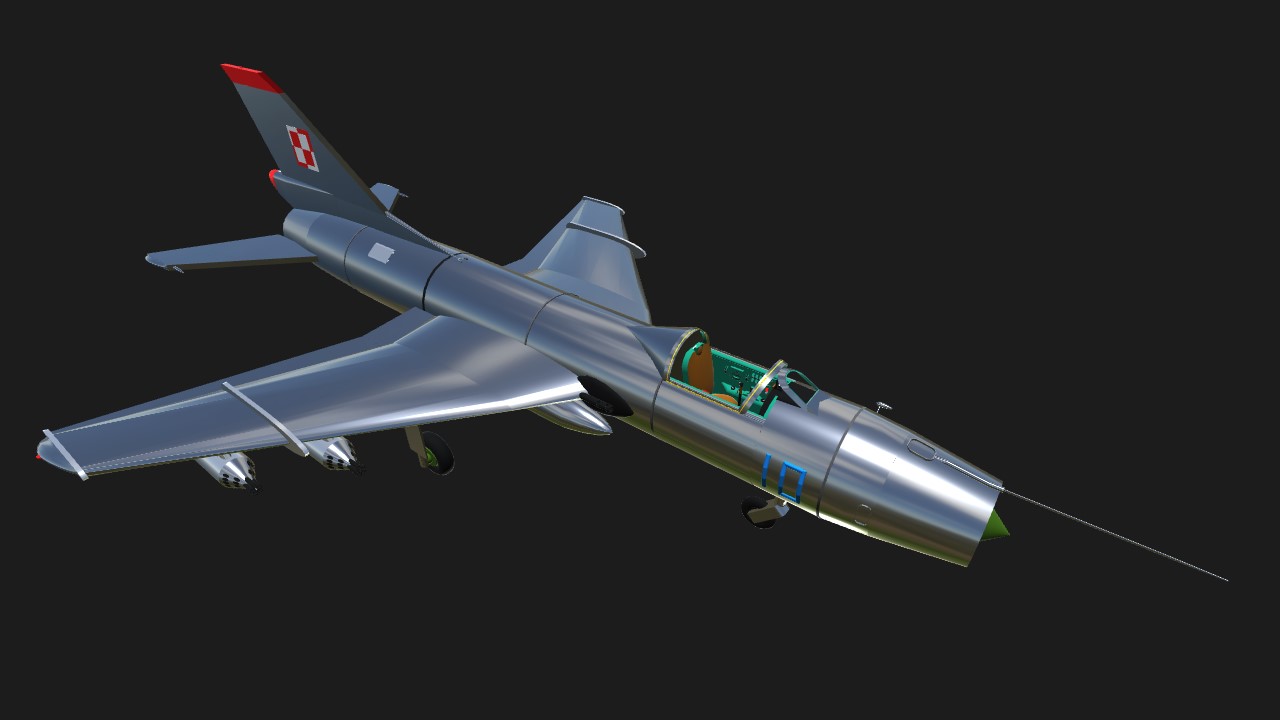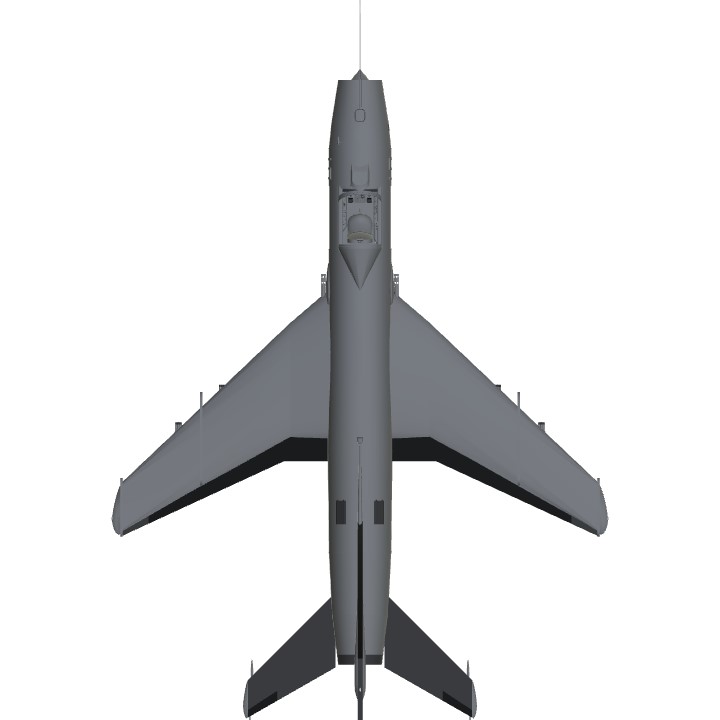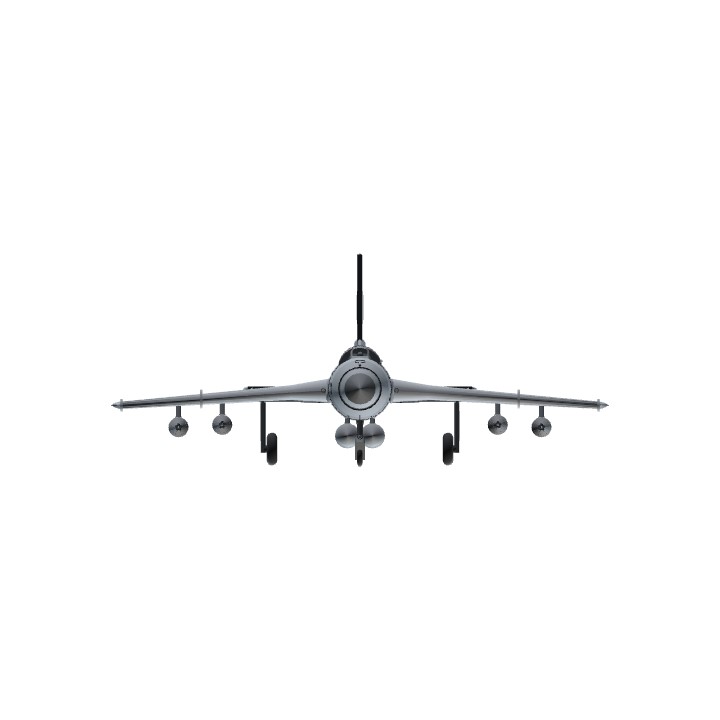( English version at the bottom of the page )
Version N°1 pour test uniquement .
Le Soukhoï Su-7 (code OTAN Fitter A) est un chasseur-bombardier à ailes en flèches conçu par l'URSS pendant les années 1950.
Le Soukhoï Su-7 est issu de la même demande que celle qui a abouti au MiG-21 .
Émise en août 1953, cette demande concernait un avion de chasse supersonique avec soit une aile en flèche soit une aile deltaIl a été construit
les livraisons aux unités opérationnelles commencèrent durant l'été 1959.
Entre temps, l'armée de l'air soviétique avait émis une nouvelle demande pour un avion d'attaque au sol, et Soukhoï avait proposé une version modifiée du Su-7.
Les principaux changements étaient un renforcement de la structure de l'avion et du train d'atterrissage. Un prototype désigné C22-1 fit son premier vol en mars
1959 avec un réacteur AL-7F, et fin avril avec un réacteur AL-7F-1. Après une série d'essais, la production en série fut lancée et les premiers exemplaires
livrés durant l'été 1960. L'avion fut déclaré opérationnel en janvier 1962.
Ces premiers Su-7 avait une autonomie très limité, et Soukhoï travaillait pour résoudre ce problème. Un prototype S22 apparut en 1961, avec des réservoirs de
carburants dans les ailes et des pylônes d'emport modifiés pour permettre d'installer des réservoirs externes. Un peu plus tard, des modifications
supplémentaires furent faites pour emporter plus de carburant dans le fuselage et améliorer l'avionique. Désignée Su-7BM, cette nouvelle version entra en service
en 1963 et fut la première à être exportée (Pologne et Tchécoslovaquie). Elle fut suivie en 1967 par le Su-7BMK destinée à l'export, avec une avionique
Dégradée, dont sept pays se portèrent acquéreurs.
Soukhoï s'attaqua ensuite à l'autre défaut du Su-7 : la longueur importante de piste dont il avait besoin (2 400 mètres pour un décollage à pleine charge).
Un système de soufflage des volets fut testé, mais n'apporta pas d'amélioration suffisante. La solution finalement retenue fut l'ajout d'une fusée à poudre
pour améliorer l'accélération lors du décollage, et l'installation de deux parachutes pour le freinage. En parallèle, des essais furent réalisés avec un
train d'atterrissage équipé d'une sorte de skis, permettant l'utilisation de terrains non préparés. Ceci abouti à la version Su-7BKL, mise en production à partir de 1965.
Le premier vol d'une version biplace destinée à l'entraînement eu lieu le 25 octobre 1965, et la production en série commença dès le mois de mai suivant.
Désignée Su-7U (code OTAN Moujik), cette version fut également déclinée en version d'export.à plus de 1 800 exemplaires utilisés par une dizaine de pays différents.
Je vous conseil pour un maximum de sensation de piloter depuis la vue interne .
- Réacteur et feux de navigation : touche 1 .
- Post Combustion : touche 2 .
- Feux d'atterrissage : touche 3 .
- Aérofreins : touche 3 + vtol bas .
- Larguage réservoir externe principaux ( fuselage ) : touche 4 .
- Siège éjectable : touche 5 .
- Parachute siège éjectable : touche 6 .
- Parachute queue : touche 7 .
- Volets : touche vtol .
- Trim .
English version .
Version N ° 1 for test only.
The Sukhoi Su-7 (NATO code Fitter A) is a fighter-bomber with arrows wings designed by the USSR during the 1950s.
The Sukhoi Su-7 is the result of the same request as that which led to the MiG-21.
Issued in August 1953, this request concerned a supersonic fighter plane with either a swept wing or a delta wing. It was built
deliveries to operational units began in the summer of 1959.
In the meantime, the Soviet Air Force had issued a new request for a ground attack aircraft, and Sukhoi had offered a modified version of the Su-7.
The main changes were a strengthening of the airplane and landing gear structure. Designated C22-1 prototype made its first flight in March
1959 with an AL-7F reactor, and at the end of April with an AL-7F-1 reactor. After a series of tests, mass production was launched and the first copies
delivered in the summer of 1960. The aircraft was declared operational in January 1962.
These early Su-7s had very limited autonomy, and Soukhoï was working to resolve this problem. A prototype S22 appeared in 1961, with tanks of
fuels in the wings and modified pylons to allow the installation of external tanks. A little later, modifications
additional efforts were made to take more fuel into the fuselage and improve avionics. Designated Su-7BM, this new version entered service
in 1963 and was the first to be exported (Poland and Czechoslovakia). It was followed in 1967 by the Su-7BMK intended for export, with avionics
Degraded, which seven countries bought.
Soukhoï then tackled the other defect of the Su-7: the significant length of runway it needed (2,400 meters for takeoff at full load).
A shutter blowing system was tested, but did not provide sufficient improvement. The final solution was the addition of a powder rocket
to improve acceleration during takeoff, and the installation of two parachutes for braking. In parallel, tests were carried out with a
landing gear equipped with a kind of skis, allowing the use of unprepared terrain. This resulted in the Su-7BKL version, put into production from 1965.
The first flight of a two-seater version for training took place on October 25, 1965, and mass production began as early as the following May.
Designated Su-7U (NATO code Moujik), this version was also available in an export version, with more than 1,800 copies used by a dozen different countries.
I advise you for a maximum feeling of piloting from the internal view.
- Reactor and navigation lights: button 1.
- Post Combustion: button 2.
- Landing lights: button 3.
- Airbrakes: button 3 + low vol.
- Main external tank release (fuselage): button 4.
- Ejection seat: button 5.
- Ejection seat parachute: button 6.
- Tail parachute: button 7.
- Shutters: vtol button.
- Trim.
Specifications
General Characteristics
- Predecessor Sukhoi 7 - test version 1
- Successors 1 airplane(s) +75 bonus
- Created On Windows
- Wingspan 32.6ft (9.9m)
- Length 47.3ft (14.4m)
- Height 14.0ft (4.3m)
- Empty Weight 20,727lbs (9,401kg)
- Loaded Weight 32,793lbs (14,874kg)
Performance
- Power/Weight Ratio 3.426
- Wing Loading 141.3lbs/ft2 (689.8kg/m2)
- Wing Area 232.1ft2 (21.6m2)
- Drag Points 7583
Parts
- Number of Parts 855
- Control Surfaces 9
- Performance Cost 2,865





@Mustang51 , You can modify it . I look forward .
@Mustang51 , That's quite right .
I think it looks fantastic and that cockpit is beautiful but it isn’t manoeuvrable enough. If you want I can make some small changes to it to make it fly a little better. Also. I think the wings aren’t swept back enough. If you use diagrams of the Su-7, it can help you get the angle exactly right. Other than that I love it
@Mustang51 , Good evening how are you . Here is the beast . Test and tell me . You can make changes if you wish . I look forward . Friendly .